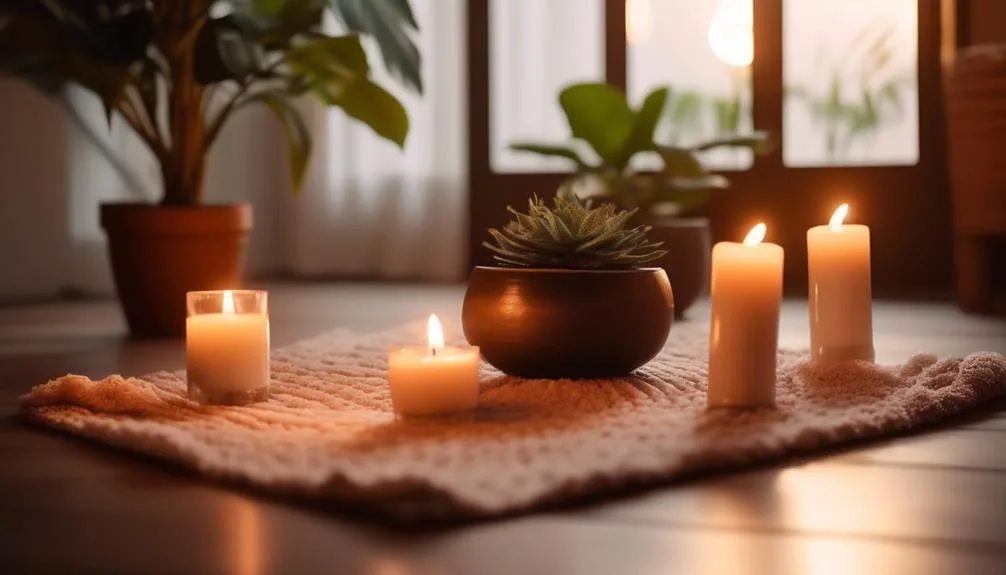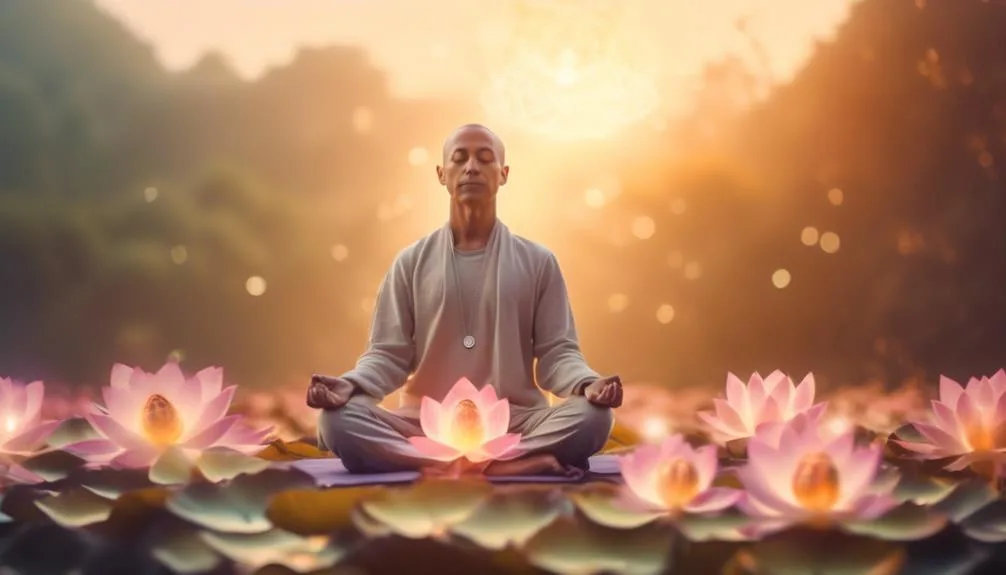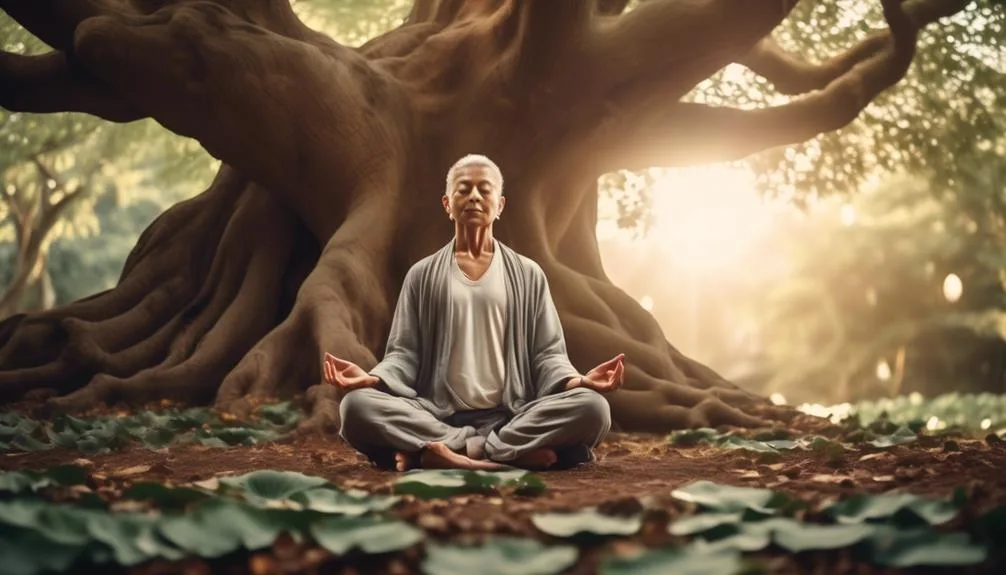Yogic Meditation: The Ultimate Guide for Beginners
Imagine you're sitting cross-legged in a serene space, the gentle hum of the world around you fading into a quiet backdrop for your thoughts.
You've heard about the tranquility and clarity yogic meditation can bring, but perhaps you're unsure where to start. As a beginner, it's natural to encounter hurdles in understanding the myriad techniques and philosophies underlying this ancient practice.
This guide is tailored to walk you through the essentials, from creating a conducive environment to mastering the initial steps of meditation.
As you ease into this journey, you'll discover not only the techniques that best suit your lifestyle but also the transformative effects they can have on your mental and physical well-being.
Stay with us, and let's explore how the simple act of turning inwards can enrich your life in ways you've yet to imagine.
Key Takeaways
- Yogic meditation is an ancient practice that promotes tranquility and heightened awareness.
- Creating a serene space free from clutter and distractions is important for a successful meditation practice.
- Focusing on the breath and using breathing techniques can help anchor attention and deepen the connection between breath, body, and mind.
- Overcoming common challenges such as body aches, fidgeting, busy mind, and noisy environment can enhance the meditation experience.
Understanding Yogic Meditation
Delving into yogic meditation, you'll embark on an ancient practice that promises tranquility and heightened awareness through simple yet profound techniques. This ultimate guide for beginners will help you understand the meditation practice, which is a journey from restlessness to stillness, from noise to silence.
Originating in India and Taoist China, it's now a global phenomenon embraced by millions.
As you start, prepare by showering, avoiding caffeine, and muting distractions. Begin with basics of meditation like breath awareness—simply focus on something as natural as your breathing. Incorporate breathing exercises to deepen your experience.
Regular meditation can lead to significant benefits, from reducing stress to improving concentration. Yoga for Beginners often includes meditation for beginners, ensuring a holistic approach to your well-being.
Preparing Your Space and Mind

Before you embark on your journey into yogic meditation, it's crucial to carve out a serene space where your mind can unwind without distractions. To foster inner peace, clear your area of clutter and choose a quiet spot that's reserved for your practice. Dedicate this time solely to meditation, ensuring you're free from interruptions.
Engage in gentle yoga or breathing exercises to foster body awareness and calm your mind before you begin. Comfort is key, so consider using cushions to support your posture. By establishing a consistent routine, as suggested in the Beginners Guide to Meditation, you'll build a habit that can significantly reduce stress.
Basic Yogic Meditation Techniques

With your space now prepared, let's explore some fundamental yogic meditation techniques to enhance your practice.
First, find a comfortable position; you can sit in a chair or on the floor, keeping your spine erect. This posture aligns your body and mind, setting the stage for effective meditation.
Now, begin to focus on your breathing. Breath Meditation is an excellent starting point as it involves simple awareness of your inhalations and exhalations. Feel the air moving in and out, and if your mind wanders, gently guide it back without judgment.
Keep in mind, the goal isn't to fall asleep but to remain alert and relaxed.
As you practice meditation, use breathing techniques to anchor your attention. With patience and consistency, you'll notice a profound connection between breath, body, and mind.
Overcoming Common Meditation Challenges

Many beginners encounter obstacles in their meditation journey, but with the right strategies, you can easily overcome them and deepen your practice. When you're new to meditation, it's normal to face hurdles that challenge your mind and body. Here's a handy table to guide you through some common challenges:
| Challenge | Strategy |
|---|---|
| Body aches | Try gentle Yoga Practices or sitting in a chair. |
| Fidgeting | Shake out your limbs before you start. |
| Too many thoughts | Focus on your breath to calm your mind. |
| Noisy environment | Change your location or use noise-canceling headphones. |
Remember to keep your eyes soft, your head and neck relaxed, and let go of stress and anxiety. You're cultivating a state of mind that supports your well-being. Keep at it, and you'll find your rhythm.
Deepening Your Meditation Practice

To deepen your meditation practice, carve out a specific time each day to sit in silence and explore your inner landscape. This Ultimate Guide encourages you to integrate Yoga Poses into your routine, as yoga involves various types of movement that prepare the body and enhance your meditation.
Make sure to be patient with yourself; deepening your practice takes time. Discover the Benefits of Yoga and meditation combined—they can improve your Body Image and overall well-being.
Try a little bit of different meditation techniques to see what resonates with you, and don't shy away from advanced methods.
Frequently Asked Questions
How Should a Beginner Start Meditation?
To start meditating, find a quiet space, assume a comfortable posture, and set a consistent timing. Begin with mindful breathing, a gentle focus, and a soft gaze. Embrace daily commitment, letting go, and mantra chanting.
What Should a Beginner of Yoga Learn First?
You should start with breathing techniques, understand yoga philosophy, and learn posture alignment. Cultivate a mind-body connection, grasp flexibility basics, and see how yoga offers stress relief while exploring energy channels and chakra introduction.
How Do I Start Yoga and Meditation at Home for Beginners?
To start, set intentions and choose a quiet space. Wear comfortable attire, learn breathing basics, and select a consistent time. Begin with gentle stretching, maintain posture focus, try guided sessions, and commit to mindful awareness regularly.
How Should a Beginner Meditate in 10 Minutes?
To meditate for 10 minutes, find a quiet environment, assume a comfortable posture, and set a timer. Focus on mindful breathing, using gentle awareness to return to your breath as a focus point.
Conclusion
You're on the brink of a journey within, poised to unlock tranquility and insight through yogic meditation. Remember, each breath is a step closer to your inner sanctuary.
Embrace the challenges; they're merely stepping stones to your growth. Start small, stay consistent, and watch as your practice transforms you.
Now, take a deep breath… are you ready to discover the serenity that awaits in the silence of your being? Your path to inner peace begins now.






